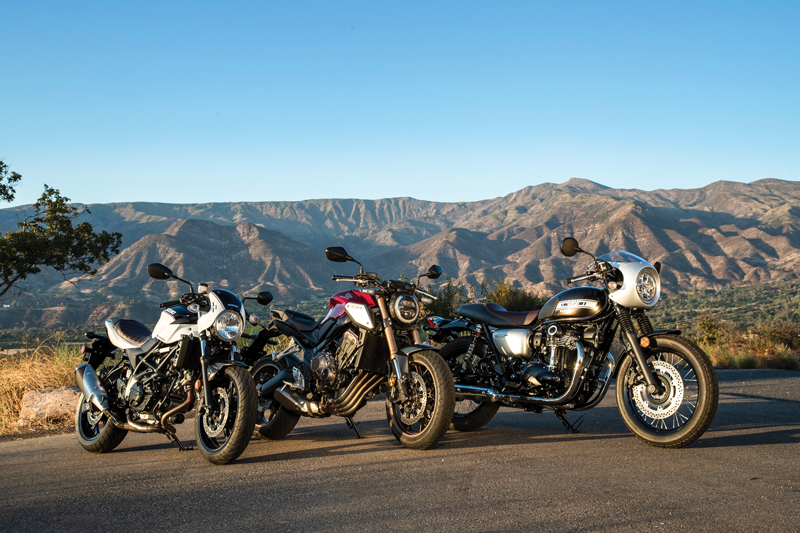
Three riders walk into a dealership…. (I know it sounds like the start of a bad joke but bear with me.) All three are in the market for a new middleweight motorcycle, and each has a unique style and riding experience in mind. They’re in luck — thanks to a challenging economy, increasing growth in female ridership and a need to attract younger riders, manufacturers are doubling down on the small- and midsize-displacement market, meaning there’s a middleweight machine out there for just about anyone. We gathered three of the newest for an unorthodox Comparo Review; rather than pitting them against each other in a head-to-head battle, we thought instead we’d focus on each one’s unique personality. So here we are, the door just swung closed behind us, and our first rider already seems to know exactly what he wants.
The Speed Demon – Honda CB650R
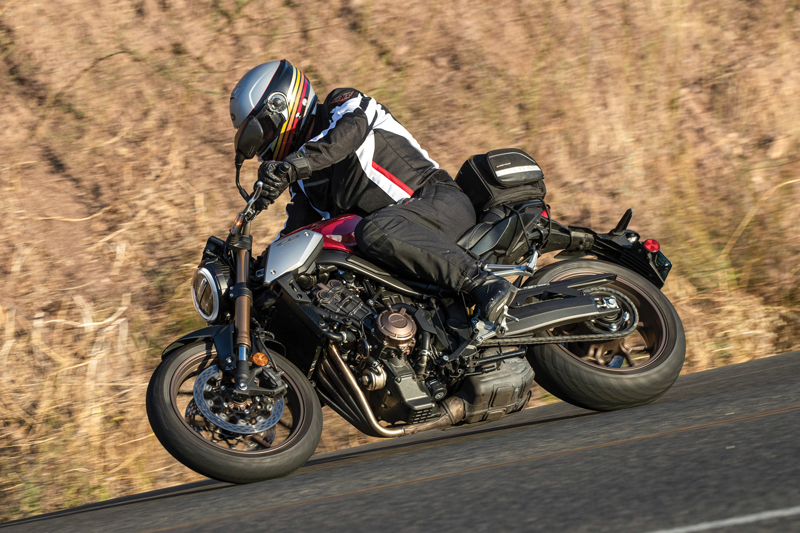
Mark’s Gear
Helmet: Bell SRT-Modular
Jacket: Fly Strata
Pants: Rev’It
Boots: Alpinestars
Tail Bag: Firstgear
We find him standing next to the Honda CB650R, where he’s admiring the waterfall of header pipes cascading from its 649cc, liquid-cooled, DOHC in-line four. The replacement for the stale CB650F, this fresh CB650R rounds out Honda’s Neo-Sports Café lineup, slotting in between the CB300R and CB1000R released for the 2018 model year.
Honda gave the middleweight CB more than just a facelift, with new wheels, an updated steel frame and a new, smaller fuel tank that combine to drop a claimed 9.2 pounds (11.6 pounds on the ABS version), a new inverted 41mm Showa fork with adjustable preload, a slightly more aggressive riding position and a redesigned airbox. The engine got a few tweaks as well, with new pistons and valve timing and a redline that’s been bumped up 1,000 rpm to 13,000. Also new this year is optional HSTC (traction control), which is only available on the ABS-equipped model and can be switched on and off on the fly.
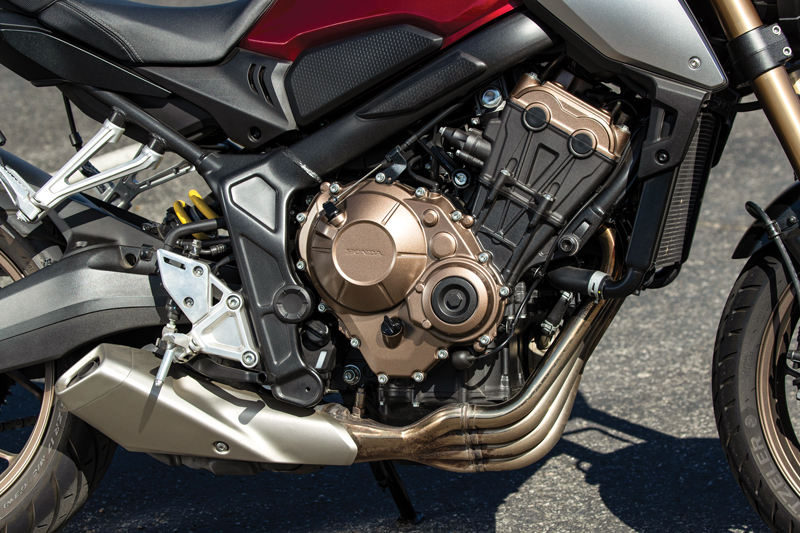
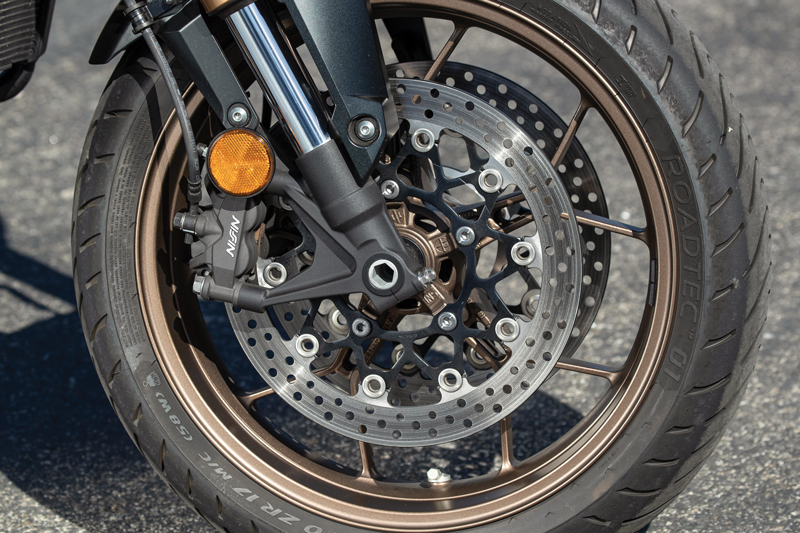
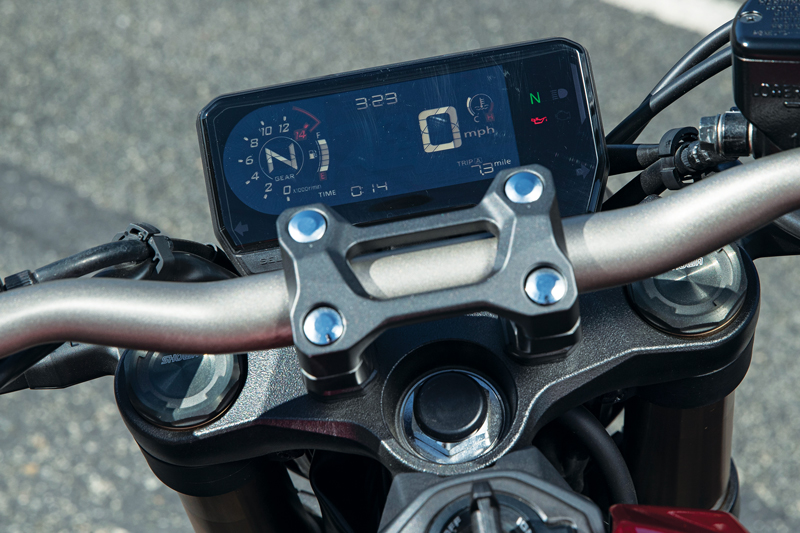
The result is a seriously sporty machine that will pluck at the heartstrings of any rider yearning for the howl of a rev-happy in-line four in an affordable, fun-to-go-fast package. This is a bike that’s happiest when wound up, with the real action not kicking in until about 6,000 rpm. Per the Jett Tuning dyno, the CB650R spins out a respectable 83 horsepower at 11,000 rpm, with torque topping out at 43 lb-ft at 8,200. “Go fast or go home,” says our rider as he swings a leg over the nearly 32-inch seat.
Footpegs are just a tad higher and farther back than before and the wide, flat handlebar is lower and more forward, but the riding position is still relatively comfortable, especially when compared to the drop-down sport position of our other two comparo bikes. With suspension front and rear being preload-adjustable, it’s easier to find a happy medium for sporting canyon runs and bombing around town, and powerful radial-mount, 4-piston front brakes pinching big 320mm discs provide more than enough stopping power. As someone unaccustomed to an in-line four with less engine braking than a twin, I was happy for the peace of mind those brakes offered when winding things up on a twisty road. While the CB could be a good first bike (Honda says 25% of its 650cc bikes are bought by first-timers), it’s got enough juice to keep an experienced rider happily entertained.
“And,” smiles our first rider as we wander away, “it’s the right color: red.”
The Distinguished Gentleman – Kawasaki W800 Cafe
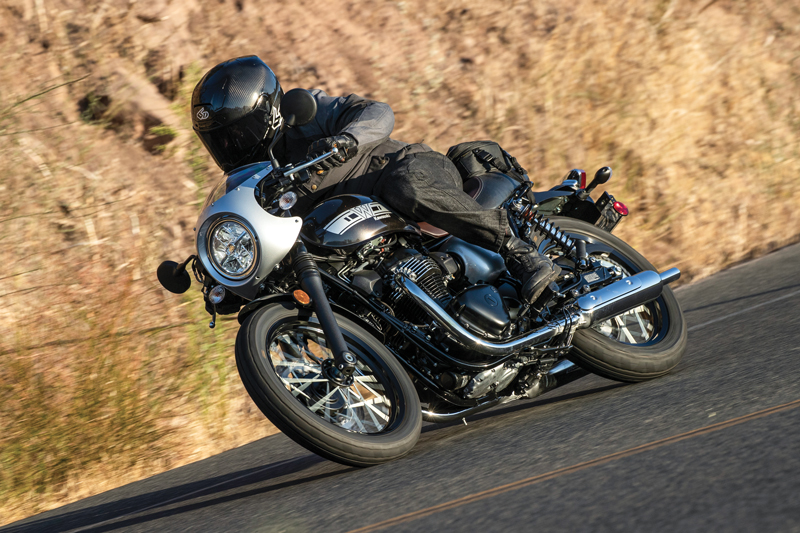
Greg’s Gear
Helmet: 6D ATS-1R
Jacket: Scorpion Birmingham
Pants: Highway 21 Defender Jeans
Boots: Highway 21 Journeyman
Tail Bag: Nelson-Rigg
It might be fair to say that rider number two is the polar opposite; he’s drawn to the Kawasaki W800 Cafe, a new model (in the U.S. and Canada) for 2019 that evokes the look and spirit of the original 1966 W1. For him, sheer performance numbers aren’t a priority, but rather classic good looks and a timeless sense of style — although a few modern conveniences like a bright LED headlight, ABS and fuel injection don’t hurt.
With the possible exception of the paint, which is a polarizing metal-flake-brown and silver combo (I happen to like it), the W800 checks all the retro-loving riders’ boxes in the appearance department. Central to that is the 773cc air-cooled, SOHC vertical twin, with its distinctive bevel gear shaft-driven cam and 360-degree firing interval. Despite its balance shaft the engine vibrates significantly at idle and throughout most of the powerband, but the wide-ratio 5-speed gearbox shifts smoothly (thanks in part to the assist-and-slipper clutch) and the chrome peashooter mufflers burble modestly. “It’s got character,” shrugs our rider.
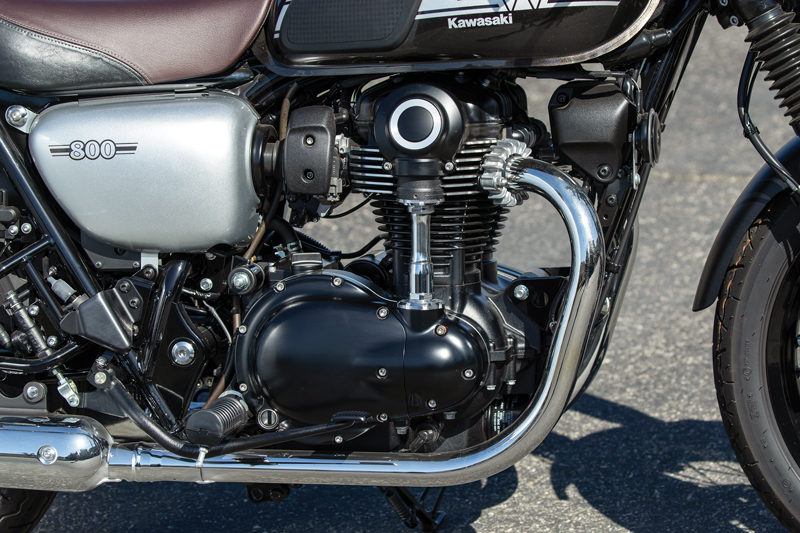
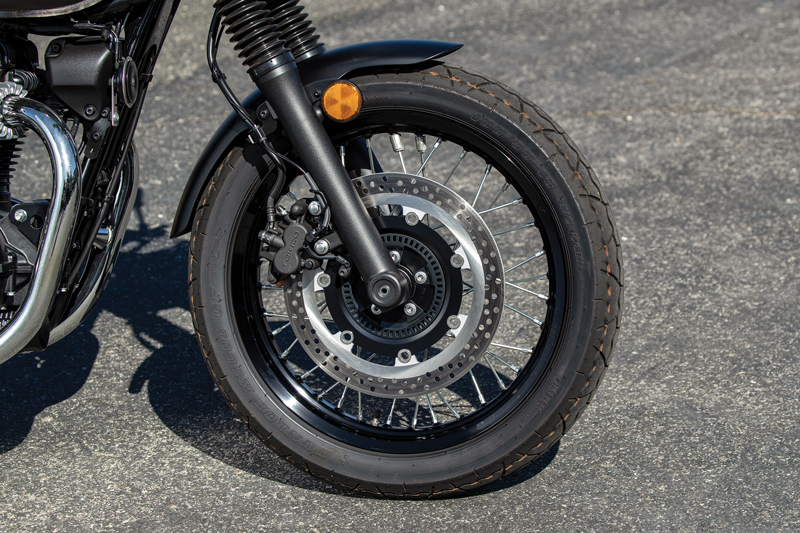
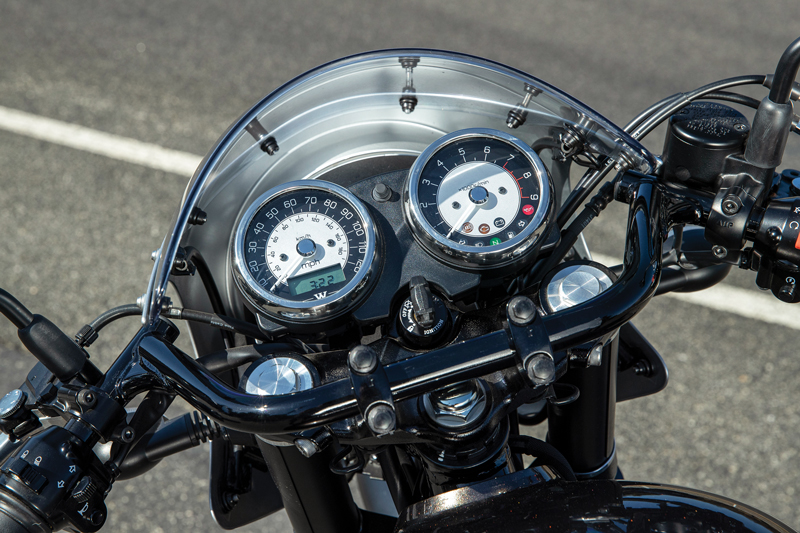
That character extends outward from the engine, with the old school double-cradle frame that was designed using Kawasaki’s advanced dynamic analysis software for new school handling, 18-inch spoked wheels rolling on tube-type Dunlop K300 GP rubber, dual rear preload-adjustable shocks, a 41mm gaitered fork and a classic clubman drop-down handlebar. The 31-inch two-tone seat is comfortable enough for about an hour at a time, and the riding position is sporty yet civilized.
Mid-mount footpegs will drag early, the vertical twin generates a middling 46.7 horsepower at 6,400 rpm and 44 lb-ft torque at 4,600, and the two brake discs, one front and one rear, both with 2-piston calipers and standard ABS, aren’t up to true sport riding levels, but that’s not what the W800 is all about. Cruising city streets and weekend jaunts into the countryside are what it was made to do, and you’re almost guaranteed to draw some admiring eyeballs when you get to your destination.
The Cool Kid – Suzuki SV650X
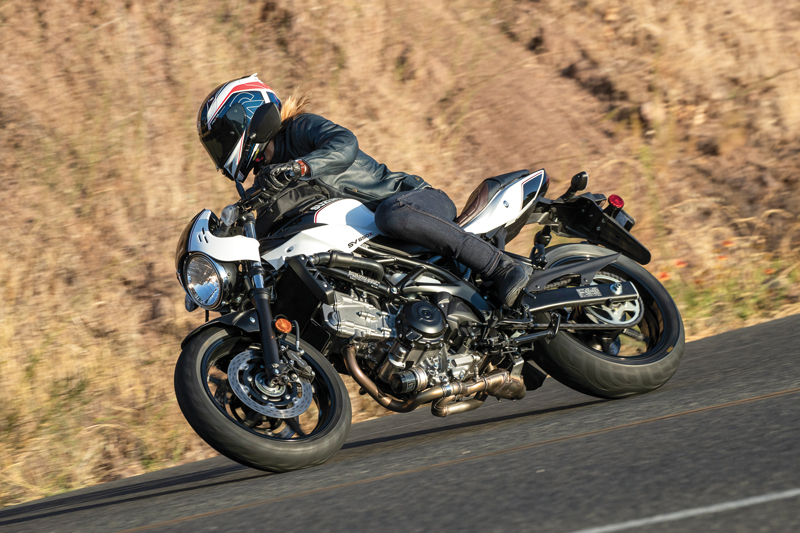
Jenny’s Gear
Helmet: HJC RPHA 11 Pro
Jacket: Flying Duchess The 66
Pants: Bolid’ster Jeny’ster
Boots: Sidi Gavia Gore-Tex
Tank Bag: Chase Harper
Now where did our third rider go? Ah, she discovered the Suzuki SV650X, which mixes the best of both worlds — sporty and retro — and also happens to be a time-tested, proven platform that’s been pasting smiles on faces since 1999, the year the original SV650 launched. In the intervening 20 years there have been S models with clip-ons and half fairings, but in my opinion this new-for-2019 café-racer X variation is the most true to the SV650’s spirit.
The bones haven’t changed: it’s still powered by the same 645cc liquid-cooled, DOHC, 90-degree V-twin that pulls strongly from idle to its peak of 69.3 horsepower at 8,700 rpm and 43.3 lb-ft of torque at 8,100, wrapped in a familiar steel trellis frame. Dual 290mm discs with 2-piston calipers up front and a single 240mm/1-piston combo at the rear work well, and ABS is standard. It’s shod with the best tires of the trio, grippy Dunlop Roadsmart IIIs.
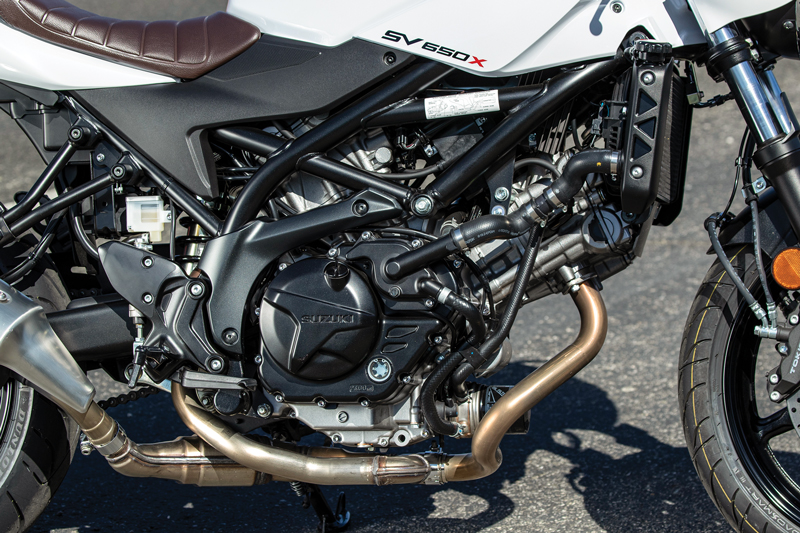
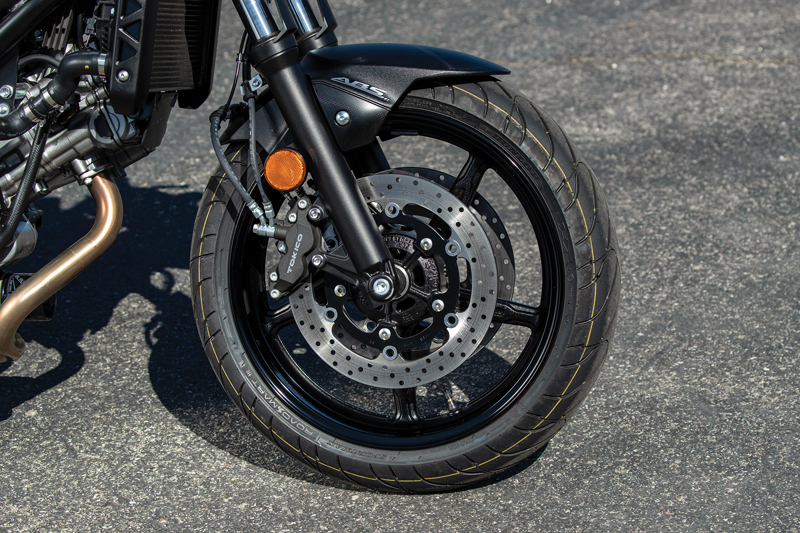
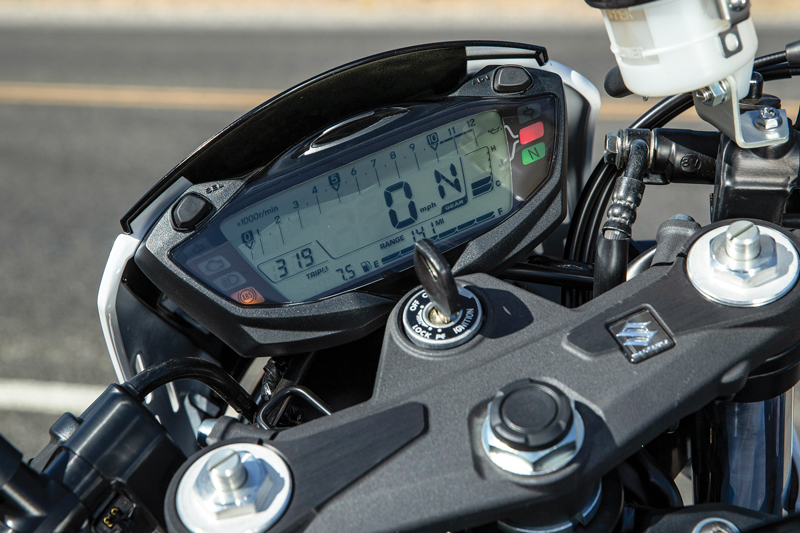
The SV650X also continues to be one of the most user-friendly middleweights out there; nearly everything about it is approachable, from its one-touch Easy Start feature and Low RPM Assist that automatically raises engine speed when releasing the clutch, to its 31-inch seat, narrow waist, predictable powerband and no-frills, easy to read, comprehensive LCD gauge.
It’s responsive and stable, cool as a cucumber, never demanding too much of its rider even when the road gets twisty, and with some suspension work it could be a great track day warrior. Best of all, it doesn’t need to be wrung out in order to have fun, and is equally happy munching through traffic or carving up canyons — though not for hours on end. The fairly long reach to the clip-ons requires a strong core, lest too much weight is placed on the hands, and the low seat and tallish footpegs create an aching need to stretch out cramped-up knees. That said, if you’re young enough, fit enough and/or willing to rest often enough, the SV650X is a cool ride that looks, feels and sounds great.
The Choice
So which one am I? The Kawasaki looks the part, but its annoying vibration, squishy suspension, uninspiring power and high price tag are turnoffs. The quick, flickable Honda is a hoot to ride, but my personal preference is for low-end grunt over a high-strung in-line four. I don’t have a long commute and we have plenty of more appropriate touring bikes in the Rider garage, so for cruising around town and half-day blasts up the local canyons, the cool-as-a-cucumber Suzuki best matched my personality. Wait…does that make me the “cool kid”?
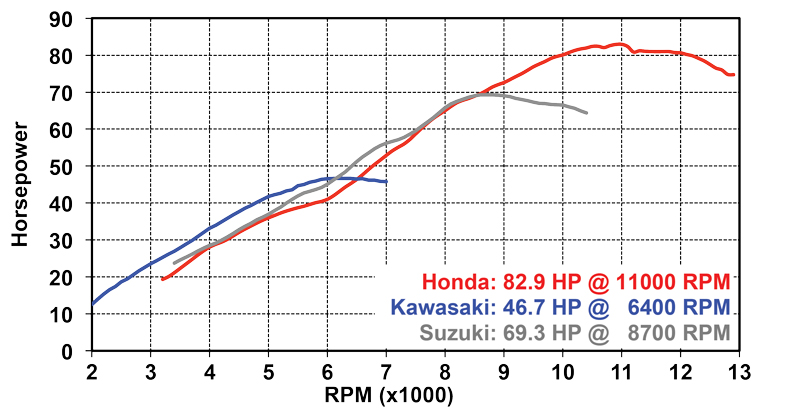
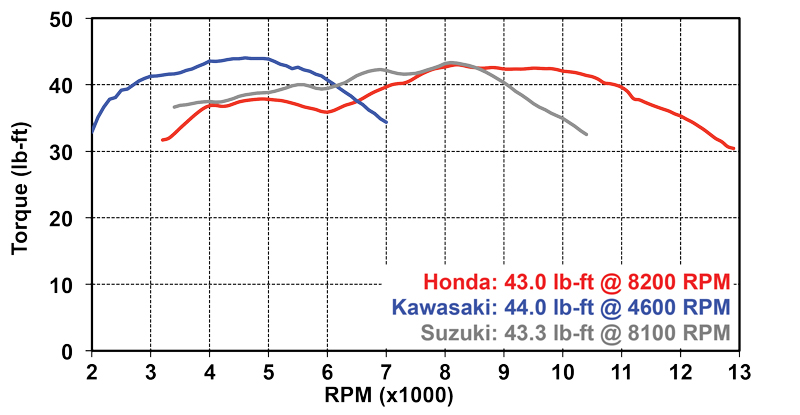
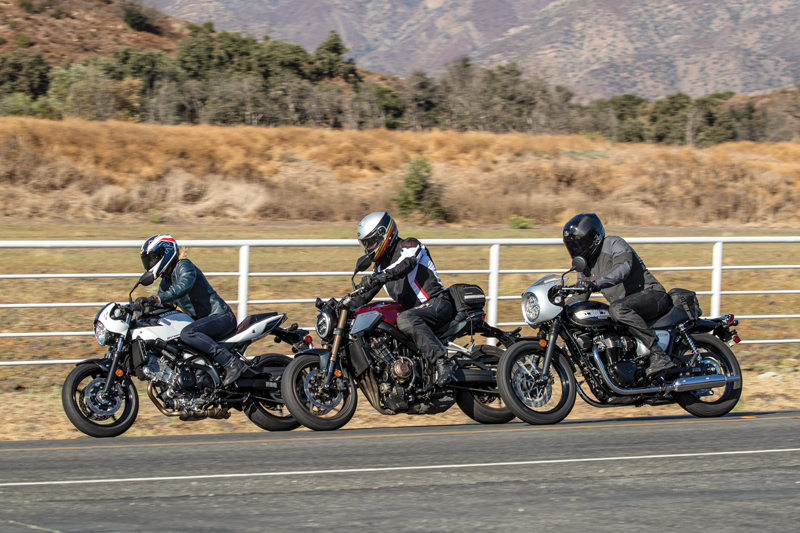
2019 Honda CB650R Specs
Base Price: $8,899
Warranty: 1yr., unltd. miles
Website: powersports.honda.com
Engine
Type: Liquid-cooled in-line four
Displacement: 649cc
Bore x Stroke: 67.0 x 46.0mm
Compression Ratio: 11.6:1
Valve Train: DOHC, 4 valves per cyl.
Valve Insp. Interval: 24,000 miles
Fuel Delivery: PGM-FI w/ 32mm throttle bodies x 2
Lubrication System: Wet sump, 2.7-qt. cap.
Transmission: 6-speed, cable-actuated assist-and-slipper wet clutch
Final Drive: O-ring chain
Electrical
Ignition: Full transistorized
Charging Output: 370 watts max.
Battery: 12V 8.6AH
Chassis
Frame: Twin-spar steel w/ aluminum swingarm
Wheelbase: 57 in.
Rake/Trail: 32 degrees/4.0 in.
Seat Height: 31.9 in.
Suspension, Front: 41mm USD fork, adj. for preload, 4.25-in. travel
Rear: Single link-type shock, adj. for preload, 5.04-in. travel
Brakes, Front: Dual 320mm discs w/ opposed 4-piston radial calipers
Rear: Single 240mm disc w/ 1-piston pin-slide caliper
Wheels, Front: Cast, 3.50 x 17 in.
Rear: Cast, 5.50 x 17 in.
Tires, Front: 120/70-ZR17
Rear: 180/55-ZR17
Wet Weight: 441 lbs.
Load Capacity: 342 lbs.
GVWR: 783 lbs.
Performance
Fuel Capacity: 4.1 gals., last 0.8 gal. fuel light on
MPG: 86 AKI min. (low/avg/high) 43.0/45.3/48.2
Estimated Range: 186 miles
Indicated RPM at 60 MPH: 4,250
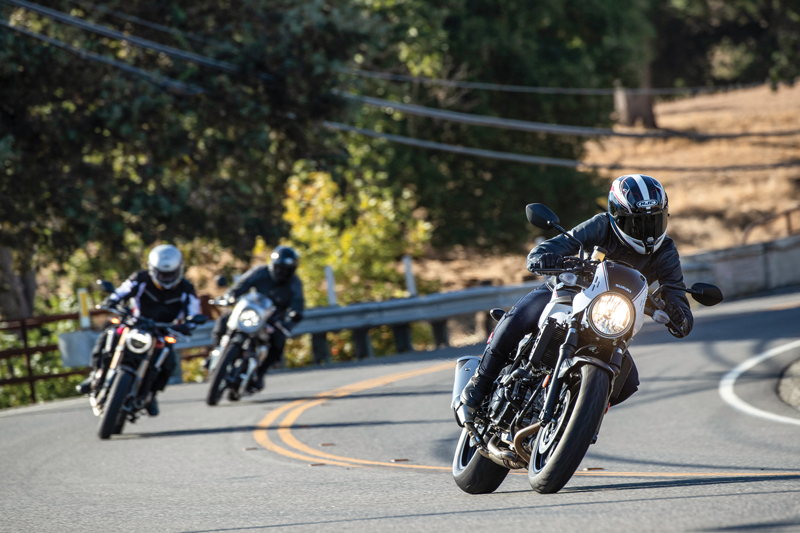
2019 Kawasaki W800 Cafe Specs
Base Price: $9,799
Warranty: 1yr., unltd. miles
Website: kawasaki.com
Engine
Type: Air-cooled parallel twin
Displacement: 773cc
Bore x Stroke: 77.0 x 83.0mm
Compression Ratio: 8.4:1
Valve Train: SOHC, 4 valves per cyl.
Valve Insp. Interval: 7,600 miles
Fuel Delivery: DFI w/34mm throttle bodies x 2
Lubrication System: Wet sump, 3.4-qt. cap.
Transmission: 5-speed, cable-actuated assist-and-slipper wet clutch
Final Drive: O-ring chain
Electrical
Ignition: Digital
Charging Output: 154 watts max.
Battery: 12V 10AH
Chassis
Frame: Double-cradle steel w/ steel swingarm
Wheelbase: 57.7 in.
Rake/Trail: 26 degrees/3.7 in.
Seat Height: 31.1 in.
Suspension, Front: 41mm fork, non-adj., 5.1-in. travel
Rear: Twin shocks, adj. for preload, 4.2-in. travel
Brakes, Front: Single 320mm disc w/ 2-piston caliper & ABS
Rear: Single 270mm disc w/ 2-piston caliper & ABS
Wheels, Front: Spoked tube-type, 2.50 x 18 in.
Rear: Spoked tube-type, 3.00 x 18 in.
Tires, Front: 100/90-H18
Rear: 130/80-H18
Wet Weight: 488 lbs.
Load Capacity: 407 lbs.
GVWR: 895 lbs.
Performance
Fuel Capacity: 4.0 gals., last 1.1 gal. fuel light on
MPG: 87 AKI min. (low/avg/high) 34.1/40.3/52.9
Estimated Range: 161 miles
Indicated RPM at 60 MPH: 3,500
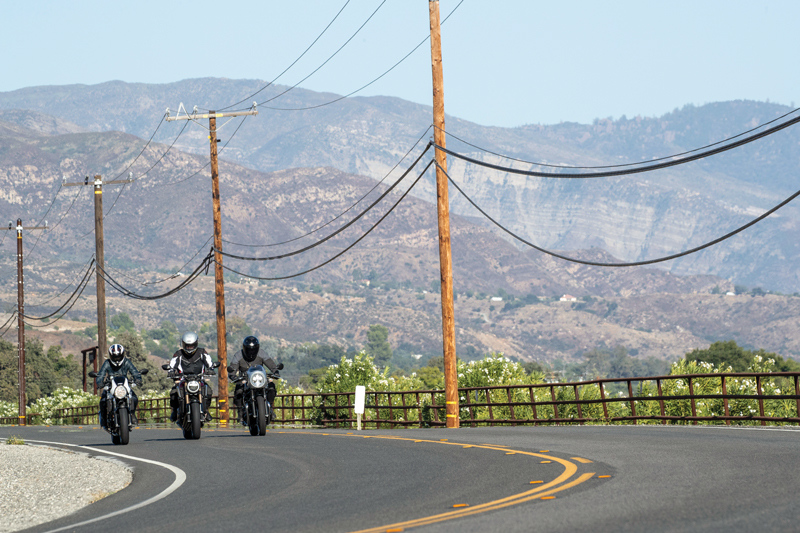
2019 Suzuki SV650X Specs
Base Price: $8,399
Warranty: 1yr., unltd. miles
Website: suzukicycles.com
Engine
Type: Liquid-cooled 90-degree V-twin
Displacement: 645cc
Bore x Stroke: 81.0 x 62.6mm
Compression Ratio: 11.2:1
Valve Train: DOHC, 4 valves per cyl.
Valve Insp. Interval: 14,500 miles
Fuel Delivery: DFI w/ SDTV & 39mm throttle bodies x 2
Lubrication System: Wet sump, 2.9-qt. cap.
Transmission: 6-speed, cable-actuated wet clutch
Final Drive: O-ring chain
Electrical
Ignition: Full transistorized
Charging Output: 375 watts max.
Battery: 12V 10AH
Chassis
Frame: Steel trellis w/ steel beam-type swingarm
Wheelbase: 56.9 in.
Rake/Trail: 25 degrees/4.2 in.
Seat Height: 31.1 in.
Suspension, Front: 41mm fork, non-adj., 4.9-in. travel
Rear: Single link-type shock, adj. for preload, 5.1-in. travel
Brakes, Front: Dual 290mm discs w/ 2-piston floating calipers & ABS
Rear: Single 240mm disc w/ 1-piston caliper & ABS
Wheels, Front: Cast, 3.50 x 17 in.
Rear: Cast, 5.00 x 17 in.
Tires, Front: 120/70-ZR17
Rear: 160/60-ZR17
Wet Weight: 437 lbs.
Load Capacity: 488 lbs.
GVWR: 925 lbs.
Performance
Fuel Capacity: 3.8 gals., last 1.1 gal. fuel light on
MPG: 87 AKI min. (low/avg/high) 38.9/53.1/58.7
Estimated Range: 202 miles
Indicated RPM at 60 MPH: 4,250

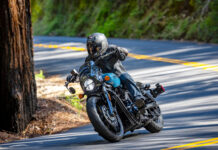






The Honda wins this one easily in my book. The most power and the best riding position. Probably the intangibles as well.
By far the Suzuki. ‘Most Power’ has zero relevance here. The pleasure of the vtwin Suzuki utterly blows away the the feeling of the other two, and there is no contest here. If you have actually ridden all three motors you can THEN and no sooner offer a valid opinion. Otherwise shut up and go back to your arm chair.
I’m not hung up on engine configuration. I love v-twins, but they are not more alluring to me than inline fours.
Who says “most power” has zero relevance here? You? That’s, like, just your opinion, man. I have ridden SVs. Wonderful bikes. I haven’t ridden the CB650, but I know what an inline four is like.
The two bikes I currently own are decidedly old school, but certainly capable machines-a 1998 Honda Super Hawk and a 2001 Yamaha FZ1. I love them both, but the Honda doesn’t get ridden much these days because I prefer almost everything about the FZ1, especially the characteristics of the engine and the more comfortable riding position.
Again, CB650R for the win here, Carl.
Rude. Cowardly. Cowardly rude.
I take it you haven’t ridden them then Carl. Because that old twin in the Suki doesn’t even feel like it has more low down grunt than the Honda, as confirmed by the torque curves up here… it just runs out of steam earlier…
I read an article late last year from a first time motorcycle buyer, who understandably did his research before buying a secondhand bike. Many people suggested, and he committed to the Suzuki 650. I’m not sure which model, but someone coined a phrase when describing the bike, and referred to it as “The Miata of motorcycles” a reference to the Mazda sports car…
Full disclaimer, I bought two bike last year, a Honda Metropolitan for my daughter to ride on Florida campus, and a Suzuki Burgman 650. The later is parked in the garage at work. I don’t think I could live without the 99 liters of dry storage.
For me, a bike (or a car) is a means to an end. So a fully faired bike just make sense.
The sv650 is good for 75hp not 69.
and I’m pretty sure those are 4 pot calipers up front.
It depends on the dyno. The results from any one dyno to the next are bound to be different unless they have been calibrated and certified against the exact same standard. Know anything about precision measuring instruments? Probably not. So far, I haven’t seen one bike test site that claims to be set up to an industry wide calibration standard. If they have, they’re not bragging about it…
From a Suzukiphile who has owned 27 Suzuki’s in a tally of 47 total, the SV650 is the biggest loser here. A V twin makes no sense. Want a second cyl, make it parallel twin, we wanted a second cyl, not a second head, a second valve cover and a bunch of other crap we cant get to cos its crammed against the frame or crammed to the radiator.
V-Twin or bust! Anyone who has ridden a gnarly Vee Twin will understand that the sound and torque reigns for street riding–esp in USA.
I-2’s are cheap engines for peasants! Get a V2, I-3 or I-4. Now those are passionate engines.
But …if you’re so stuck on I-2 economy get a CB500 or Ninja 400. I got a nice big Vee in my cruiser and the sound and torque is to die for! I could not rev an I-4 enough on the street without getting a ticket… i prefer more low-down torque.
Racing, thats different. But if youre racing on the street with these cell phone soccer moms and ignorant elderly cagers… you’re being a fool. You will die. If you must get an I-4, and are experienced, also consider the Suzuki GSX-S750. It sounds proper! The CB650R sounds like shit for an i-4. It’s also tall comparex to the CBR600’s.. which is stupid. The CBR600’s sounded great tho. Im short and could fit well on an old ’13 model. Not sure y Honda made the seat height so tall on the 650R… it’s a Standard bike that is unnecessary. I fit great on the SV650. Which is the KING of these 3 bikes afaiac
In-line 2-cylinder engine with a 270° crank sound just like a v-twin & get the same torque characteristic . Example is the mt-07 . But I know that most of the twin are from the 180 deg crank variety . ( not the w800 here & older triumph : 360 deg ) . One thing I agree with Srinath is the fact that ” a second head, a second valve cover and a bunch of other crap” all those complicate the architecture and take more time to adjust . One thing a parrallel twin could’nt match is the mass centralization of a v-twin or more exactly an L-engine like the SV .
One of my favorite bikes (of many) was a Yamaha TR1 a 1,000cc street bike with a cruiser engine. The solid slug of torque at low revs always made it fun to roll out of corners in an effortless fashion, and the engine braking meant I seldom had to use the brakes at normal speeds. So it was just so simple to ride one of our mountain roads, rarely changing gear and always with a feeling of complete control. The engine was entirely tractable , the bike was very narrow and easy to ride as a middle weight, but with no lack of power, and plenty of speed up to to 180kph, which is fast enough.Sigh. If only Yamaha made one still today…
Anything more than a single is shite! LOL
Srinath,
Really if we were looking for pure ease of maintenance we’d all want hydraulic lifters, or at least screw and lock-nut adjusters with access windows like the Honda SOHC engines of the 70s had, or like small-block Moto Guzzi’s have now. In reality, there is a balance between maintenance, the difficult part of which only needs to be performed every 4-10 years for most riders, and performance. I tend to prefer my 700cc and smaller bikes to be 90 degree v-twins because of the combination of torque and minimal vibration.
Kawasaki got a good tastef of ride.
It’s amusing to me to see the old Suzuki still hitting all the sweet spots…..I’m currently riding an ’06 vstrom 650 – the SV’s weird uncle. I’ve ridden lots of motorcycles over the years, and while it’s not a powerhouse, the Suzuki 650 mill is such a fun motor to run thru the gears, and it’s smooth running too. Suzuki really nailed it with this engine design (it’s essentially the same engine from waaaay back), and it seems I’m not the only one to agree.
There are two bikes here cheap at the cost and one weirdly overpriced. Marketing aside, I do believe Suzuki’s V2 650 is one of the best engines ever manufactured. While reasonable price point drives why they bury that little jewel in a mediocre package, I do wish Suzuki would go nuts and offer the 650 all dressed. Like a (very?) few crazies, I’d pay $15000 for a limited production SV650RR.
Spend $400 on AK25 cartridge emulators and $70 on a used GSXR shock. The beauty of a SV650 is you can turn it into a great commuter and peg scratcher for not much scratch.
Maybe it boils down to personal preference, but I just don’t consider anything with more than two cylinders to be a motorcycle engine. Cars have in-line fours…… and I really don’t enjoy driving cars. (two stroke triples might be an exception)
I may be weird (or hungry…nup, had breakfast) but I tend to agree with you. The only time inline fours appeal to me is when accelerating in a straight line…13,000rpm is where it’s at for sure! But for traveling along a winding road ( which is all of our roads in New Zealand), a twin is the way to go, or a single if speeds are modest. A flat twin is like a tight rope walker’s balancing pole for cornering poise, as long as an adult is in charge of the throttle.
The worst aspect of an inline four is especially the Honda variable valve design, which is like a light switch in some models. Imagine trying to negotiate a twisty mountain road (again, most of our road are like this) at a steady speed. You are following the contour of the road and riding as smoothly as you know how. Then the road rises uphill, so you automatically add a little throttle to compensate. Without an eagle eye on the tachometer ( you ought to be looking at the rod, dummy), you inadvertently shift into the VVT zone. The bike suddenly accelerates, altering the arc of your intended line, and pushing you into understeer, into the path of oncoming traffic. Is this fun anymore? No way at all. This happened to me several times during my brief ownership of a CB400. I survived. The designer, and anyone who signed off on the design, shouldn’t.
Everyone know inline fours produce hp.
My thinking Kawasaki is competing with
The middle weight category… Against Triumph … Even down to the retro look
I would have liked to see the Husqvarna Svartpilen added to this test.
Also, the big downside of Honda here is that it’s made in Thailand, while Kawasaki and Suzuki is pure Japanese, fully made and assembled in Japan… It will eventually show up later in terms of reliability.